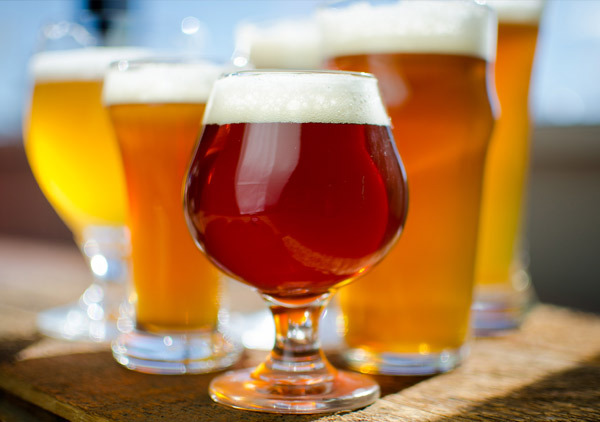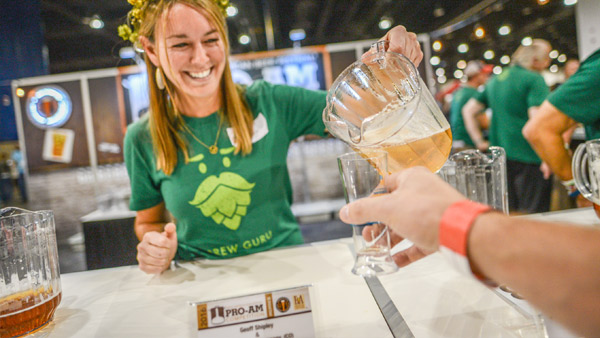
Want to know the best-kept secret at the Great American Beer Festival (GABF)? The Pro-Am booth. While many festival-goers scramble about and queue up for their favorite breweries, attendees of the Pro-Am booth stay put and work their way around more than 30 award-winning beers, all developed by homebrewers. The selections change with each day of the festival, rotating through the 90-plus entries of various classic and boundary-pushing styles.
There were 91 beers judged in the 2016 GABF Pro-Am Competition, each having humble beginnings in a kitchen, garage, or back patio. Each beer is an award winner before it even arrives to Denver, having already won a medal in a Beer Judge Certification Program/AHA-sanctioned competition or a brewery-run competition. The accomplished homebrewers then team up with pro breweries and enter their award-winning homebrews into the GABF Pro-Am Competition.
Only three of the 91 are dubbed GABF medal winners, but the other 88 are excellent as well. We talked to a few of the non-medal winners about their experiences with the GABF Pro-Am competition and got our hands on a few recipes along the way.
What competition did your homebrew recipe win?
Nate Levengood: I won gold in the Wizard of Saaz competition organized by the Society of Akron Area Zymurgists, as well as in the Ohio State Fair. [Editor’s note: Nate teamed up with Millersburg Brewing Co.
David Hellen: I won Bell’s 2015 Homebrew Competition. They hold it annually each fall, and the winner gets to brew at Bell’s Brewery the following year.
Robbie Proctor: My homebrew club, DOZE, holds an annual competition with Black Diamond Brewing Company for the GABF Pro-Am. It’s a best-of-show style competition, with the only limits being yeast choice and a few of the harder to get hops.
Sean Kampshoff: I won the 3rd annual Lift Bridge Brewing Company homebrew contest.
What was it like to team up with a brewery to create your recipe?
NL: Brewing on a professional scale is quite a tilted experience to the small scale in your garage. The differences in scale produce real hurdles (like taking 12 oz. of coconut for 10 gallons up to a 310-gallon equivalent). Lov-a-ly Bunch of Coconuts Sweet Stout was no different.
Also as a homebrewer, it’s easy for us to have a pantry of odds and ends of malt or just stop at the local supply store for a grain bill. Breweries have a cache of malts to fit their routine brewing lineup, and it’s not always possible to have the exact grain/hop bill available. Everyone earns their stripes by substituting ingredients without compromising the finished product.
DH: It was awesome to see Bale So Hard Dry-Hopped Saison brewed on such a large scale. I’m used to making my 5-gallon batches, and we made over 400 gallons at the brewery. It’s humbling to be there but also inspiring in that the systems are not all that different from a homebrew setup. There is very much a connection with each step in the process at both scales.
At that scale, it’s easy to see that equipment does not make great beer, people (and yeast) do. I worked with Zeke Bogan and crew at Bell’s, and it was evident they have immense experience with their equipment.
RP: As a homebrewer, it’s a dream come true to brew a professional batch, especially if it’s your own recipe, like my Weaver’s Gold British Golden Ale. Justin Burdt (head Brewer), Christian (assistant), and Shawn Whitaker (Production Manager) were super excited to brew Weavers Gold and welcomed me and Terry Hillard (brewing buddy from DOZE) with open arms.
We got together a few times to talk about the beer and how we’d do the recipe justice on a 15-barrel system. English styles aren’t too complex, so we didn’t have lots of hoops to jump through. The biggest challenges were the bittering charge and the whirlpool additions because IBU extraction at that scale is quite different.
SK: It was a great experience working with Matt Hall, the head brewer at Lift Bridge, and the rest of his team. I met with Matt, talked through my recipe, Sean’s Bock Doppelbock, and decided we didn’t want to change much. We scaled up the recipe using an Android homebreiwng app I’m working on with the only challenge of rounding up to full grain bill bags to make the process more efficient.
I had a great time on brew day despite battling a fever. I pushed through and did my time with the grunt work of lugging grain bags and cleaning out the mash tun manually. Something I learned: if you know you’re going to be cleaning up the mash, it’s a better idea to enter and win with a session beer rather than the largest grain bill this brewery had seen to date. Live and learn.
How long have you been brewing?
NL: I’ve been brewing for around five to six years.
DH: I’ve been brewing for five or six years.
RP: I started on the stove top in 2011, when I used my upcoming wedding as a good excuse to finally start homebrewing. I moved up to my own outside burner and a couple of Igloo coolers two years ago and have been brewing mainly 5-gallon batches since then.
SK: I’ve been brewing for 11 years.
Any advice for homebrewers out there?
NL: Besides the standard sanitation blurb, I finally started seeing consistent, award-winning results when I started paying attention to water chemistry. With the help of water spreadsheets, like Martin Brungard’s Bru’n Water, I was able to shoot for a pH between 5.2 and 5.6. Without knowing any reader’s specific water, I would recommend a couple teaspoons of calcium chloride and maybe a half teaspoon of gypsum. The chlorides will round out the malty-sweet profile we are going for here.
DH: Get to know your process and pay attention to details. Brew what you like, and it will surely get better each time you brew it.
RP: What I like to do is brew what I like to drink and experiment within that range. Split batches, try different yeasts on the same wort, dry hop with different varieties, don’t be afraid to blend the split batches back, and don’t be afraid to get advice. The more feedback you can get on one beer, the better able you are to sort through it all and see if there are any common threads that you can work on improving.
SK: Get in touch with the brewer ASAP if you win a Pro-Am competition. With my winning beer being a high gravity lager that posed some logistical issues, Matt was able to get all of the grain ordered quickly as well as a big yeast pitch. Luckily the brew schedule was open so we could get brewing immediately.
* * *
American Homebrewers Association Competition Coordinator John Moorhead is director of the National Homebrew Competition, coordinates the Great American Beer Festival® Pro-Am Competition and the Capitol Hill Staff Homebrew Competition, and writes for HomebrewersAssociation.org.





Share Post